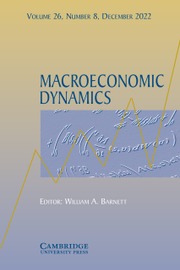Article contents
MONEY AS A MEDIUM OF EXCHANGE WHEN GOODS VARY BY SUPPLY AND DEMAND
Published online by Cambridge University Press: 02 March 2005
Abstract
Models of the exchange process based on search theory can be used toanalyze the features of objects that make them more or less likely toemerge as money in equilibrium. These models illustrate thetrade-off between endogenous acceptability (an equilibrium property)and intrinsic characteristics of goods, such as storability or recognizability. We look at how the relativesupply and demand for various goods affect their likelihood ofbecoming money. Intuitively, goods in high demand and/or low supplyare more likely to appear as commodity money, subject to thequalification that which object ends up circulating as a medium ofexchange depends at least partly on convention. Welfare propertiesand fiat money are discussed.
Keywords
Information
- Type
- Research Article
- Information
- Copyright
- © 1997 Cambridge University Press
- 7
- Cited by

